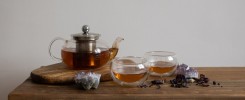From my years working directly with tea plantations, tasting countless samples, and sourcing for international clients, I can say that the teas highest in caffeine are typically matcha and other shade-grown green teas like gyokuro, followed by robust black teas such as Assam and Ceylo, and then young raw pu-erh (sheng) teas. But the real impact on alertness depends on multiple factors: leaf quality, harvest timing, processing, and brewing technique.
When I first started working in the tea industry, I was surprised by how much variability there is—even within the same tea type. Take matcha, for example. Because you consume the entire powdered leaf, the caffeine content is concentrated, and combined with L-theanine, it produces a very different effect than coffee. From my personal experience, a high-grade ceremonial matcha gives me sustained mental clarity without any jitteriness, and I’ve seen the same in clients who regularly drink it before work or study. Gyokuro behaves similarly; during my visits to Japanese tea farms, I noticed the growers shading the plants several weeks before harvest, which forces the plant to produce more chlorophyll and amino acids, increasing both flavor complexity and caffeine concentration.
Black teas tell a different story. During my years sourcing Assam for export, I noticed that second-flush leaves from the youngest shoots consistently contained the highest caffeine. A strong Assam infusion gives a clean, wakeful energy that I often rely on in the mornings when I need to focus during long tastings. Ceylon and Darjeeling second flush teas are a little lighter in effect, but when brewed correctly, they can be surprisingly energizing. I also learned that the estate, altitude, and exact harvest period make a huge difference—two lots of Assam from different gardens can feel completely different in terms of alertness.
Raw pu-erh is another interesting case. I’ve tasted young sheng cakes from Yunnan estates that deliver a slow, sustained stimulant effect. Unlike black tea, which spikes alertness quickly, raw pu-erh gives me energy that lasts hours, and it also feels gentler on my stomach. I often recommend it to colleagues who want caffeine without the sharp spike of coffee. Oolongs fall somewhere in between: lightly oxidized high-mountain oolongs give moderate caffeine, while heavily roasted or aged oolongs generally produce less.
Brewing method is something I can’t overstate. I’ve spent countless hours demonstrating proper steeping to clients, and I’ve seen the same tea feel completely different depending on temperature, leaf amount, and steeping duration. For example, boiling Assam leaves for five minutes produces a very different stimulant effect than a shorter gongfu-style infusion. Even matcha can feel “too strong” if whisked with excessive powder, while the right ratio gives optimal clarity and focus.
For me, the key insight from years in this industry is that caffeine alone does not define a tea’s effect. I’ve experienced matcha providing calm alertness, Assam giving a sharper energy boost, and raw pu-erh delivering gentle but persistent focus. The flavor, aroma, and interaction with L-theanine, polyphenols, and fermentation compounds all shape the experience. What keeps tea enthusiasts engaged—and what I always emphasize to my clients—is paying attention to how your own body responds. Two people drinking the same cup can feel very different results, which is why experimentation and mindfulness are critical.
So, which tea is highest in caffeine? In terms of raw numbers, it’s matcha and gyokuro, followed by strong black teas like Assam, and then young raw pu-erh. But from my perspective, the real lesson is understanding how leaf quality, cultivation, processing, and brewing interact to create the actual effect on your body and mind. Drinking tea is not just about caffeine—it’s about ritual, flavor, and the nuanced interplay of chemistry and human perception, something I’ve come to deeply appreciate after years in the field.

